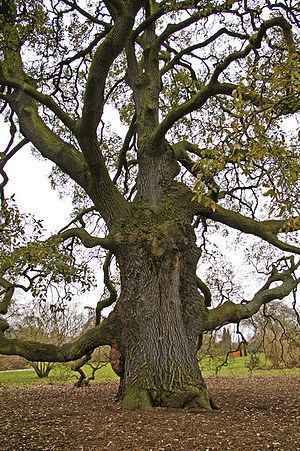Name William Lucombe | ||
 | ||
William Lucombe (before 1720 – after 1785) was a horticulturalist and nurseryman, who discovered and gave his name to the natural hybrid Lucombe Oak (Quercus × hispanica 'Lucombeana'), a semi-deciduous oak tree..
Contents

History
Lucombe began his horticultural career as Head Gardener in the service of merchant Thomas Ball at Mamhead Park circa 1720. It was while working at Mamhead that he founded his nursery, marketing many of the plants collected by Ball during the latter's commercial travels abroad, most famously the Holm Oak.
Lucombe bred his eponymous oak at his nursery in St Thomas, Exeter, which he founded in 1720 (now Pinces Gardens). It was the first commercial plant nursery in southwest England.
Lucombe Oaks
The natural hybrid Lucombe Oak was first spotted in 1762 when Lucombe noticed that one of the saplings produced from a Turkey Oak acorn he had planted kept its leaves in winter. He later observed that these features occurred where both parent species grew, Quercus cerris (Turkey Oak) and Quercus suber (Cork Oak). True Lucombe Oaks are clones of the original tree, but the name 'Lucombe Oak' is also often used to refer to any hybrid between Turkey Oaks and Cork Oaks.
One of the early Lucombe Oaks went to Kew Gardens. Lucombe Oaks along with their descendents, which include back crosses with the naturalised Turkey Oak, are common in the landscape of East Devon, as well as in parks and gardens. The Tree Register of the British Isles−TROBI Champion is at Phear Park in Exmouth, measuring 26 metres (85 ft) in height, with a trunk diameter of 261261 centimetres (103 in) in 2008.
Lucombe felled the original hybrid in 1785, keeping timber from it from which his coffin was to be made when he died. He stored the boards under his bed. However, he lived, for the age, an exceptionally long life, dying at the age of 102 years. By that time the planks had decayed in the Devon dampness. Instead, on his death, timber from one of his early graft propagations was used to make his coffin.
